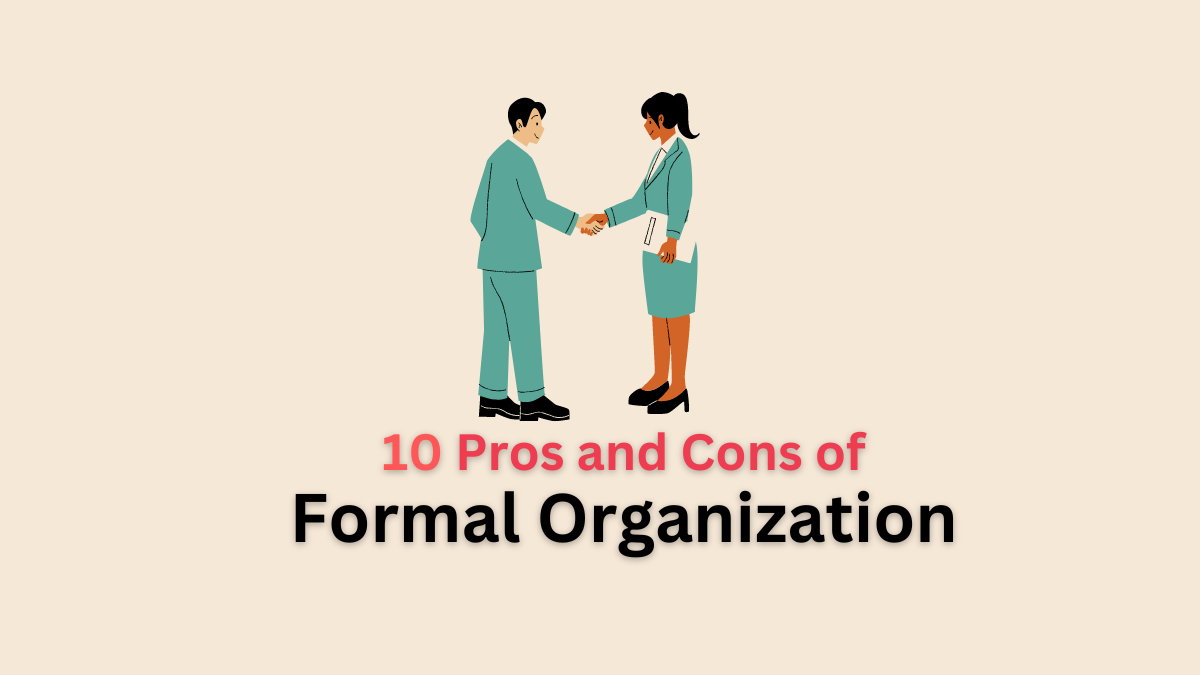Pros and Cons of Formal Organization
A formal organization is an organizational setup where positions, duties, responsibilities, and authorities are clearly defined. This structure is often visually represented through an organizational chart and operates under strict rules and procedures.
Here, we will delve into 10 major pros and cons of formal organization in business, so let’s get started:
Pros of Formal Organization
Below are the five main advantages of formal organizational structure:
Systematic Working
Formal organizations are structured to ensure that each job is well-defined with specific roles and responsibilities. This structured approach leads to systematic and smooth functioning, where activities are coordinated and organized efficiently.
The clear division of labor minimizes confusion and overlap, ensuring that each task is performed correctly and efficiently, contributing to overall organizational effectiveness.
Clear Authority and Responsibility
In a formal organization, the chain of command is clearly defined. Each position within the organization has specific authority and responsibility, which is crucial for maintaining order and discipline.
This clarity helps in reducing ambiguity and conflict, as employees know exactly what is expected of them and to whom they report. It also facilitates accountability, as individuals can be held responsible for their specific duties and outcomes.
Stability
Formal organizations operate under established rules, procedures, and policies. This ensures that operations continue smoothly even when there are changes in personnel, such as the departure of key managers.
This stability is vital for long-term planning and consistent performance. It allows the organization to maintain its operations and achieve its goals without significant disruptions caused by personnel changes.
Professional Relationships
Formal organizations prioritize professional relationships over personal ones. Interactions are based on work-related roles and responsibilities rather than personal connections.
This professional approach fosters a work environment where merit and performance are the primary criteria for decision-making, reducing bias and favoritism. It also helps maintain a focus on organizational goals rather than individual interests.
Read More: 10 Pros and Cons of Process Departmentalization
Enhanced Coordination and Communication
The hierarchical structure of a formal organization ensures that communication flows through a defined chain of command. This systematic communication process ensures that instructions and information are passed accurately and efficiently.
Enhanced coordination and clear communication channels help in aligning the efforts of different departments and employees towards common goals, improving overall organizational efficiency.
Cons of Formal Organization
Now, let’s explore the five key disadvantages of formal organization in the business:
Slow Decision-Making
In formal organizations, decision-making often follows a hierarchical process where approvals are needed from multiple levels of management.
This can lead to delays, especially when swift action is required. The slow decision-making process can hinder the organization’s ability to respond quickly to market changes or unexpected challenges.
Read More: 10 Major Pros and Cons of Delegation of Authority
Rigidity
Formal organizations often have rigid structures and strict adherence to rules and procedures. This rigidity can stifle creativity and innovation, as employees may be discouraged from thinking outside the box or proposing new ideas. It can also make the organization less adaptable to change, leading to stagnation in a dynamic business environment.
Neglect of Social and Psychological Needs
The focus in formal organizations is predominantly on work and professional relationships, often at the expense of employees’ social and psychological needs.
Ignoring these needs can lead to employee dissatisfaction, low morale, and decreased motivation. Over time, this can result in higher turnover rates and reduced productivity, as employees may feel undervalued and disengaged.
Read More: 10 Pros and Cons of Decentralization of Authority
Higher Operational Costs
Maintaining a formal organizational structure can be resource-intensive. It often requires significant investment in administrative processes, documentation, and compliance with established procedures.
The higher operational costs associated with maintaining formal structures can be a financial burden, especially for smaller organizations. These costs can include salaries for multiple layers of management, extensive training programs, and other administrative expenses.
Mechanistic Approach
Formal organizations tend to operate like well-oiled machines, with a strong emphasis on following established procedures and protocols.
This mechanistic approach can lead to a lack of flexibility and human touch. Employees may feel like cogs in a machine, which can demotivate them and reduce their sense of ownership and commitment to their work. Additionally, it can prevent the organization from leveraging the full potential of its human resources, as individual talents and creativity may be overlooked.
Hence, the above-mentioned are the 10 major pros and cons of formal organization in business.
